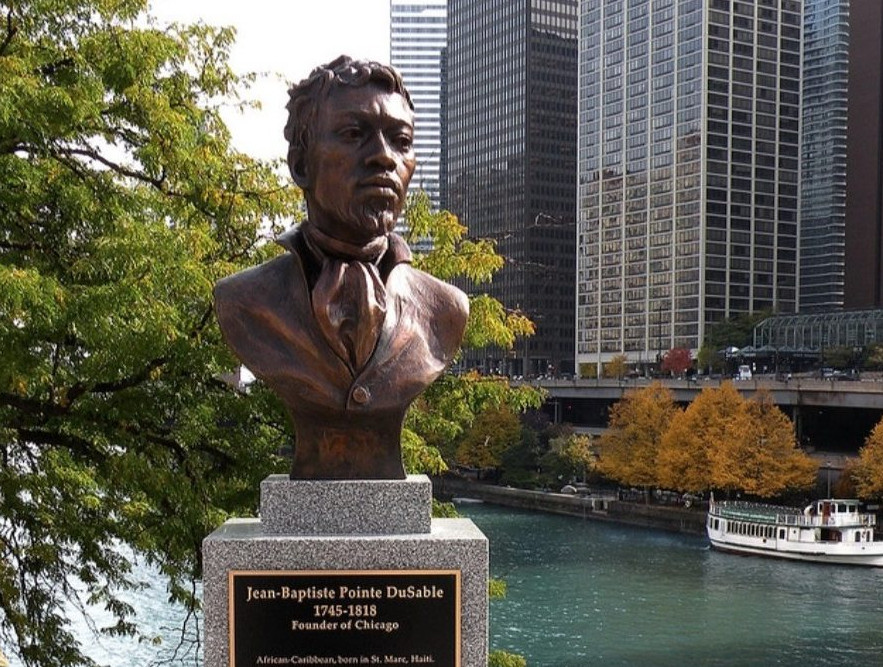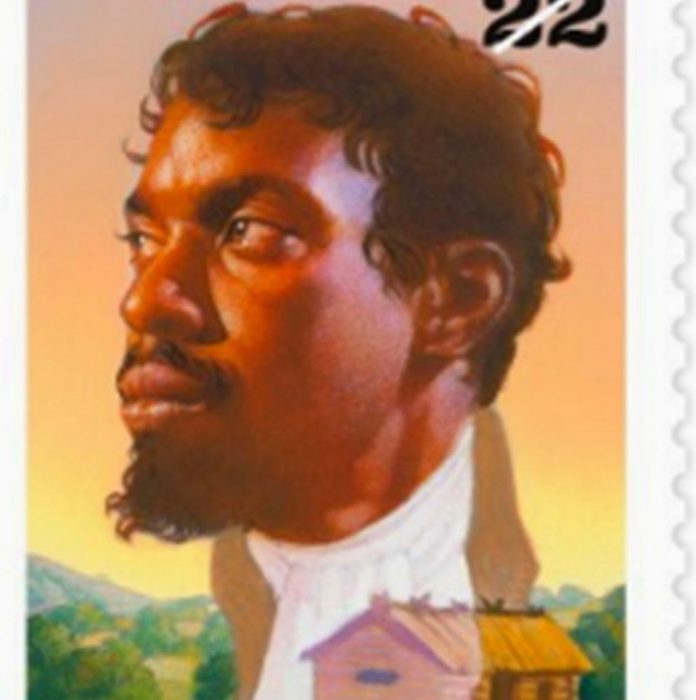Quick Summary
Date of Birth: 1745
Died: 28th August 1818
Other Names: Point de Sable, Point au Sable, Point Sable and Pointe DuSable
Occupation: Trader
Known for: He is known as the “Founder of Chicago” since he was the first permanent non-Indigenous settler in what would later become Chicago, Illinois.
Family: Spouse, Kitihawa or Catherine. He also had two children with her
Who is Jean Baptiste Point Du Sable?
Jean Point Du Sable is widely known as the first permanent settler of a region, which is now known as Chicago, Illinois. He is also known as the founder of modern-day Chicago. There are many places that have been named after Point de Sable, such as a park, bridge, road, school, museum and a harbour.
For the most parts of his life, Point Du Sable lived by the mouth of the Chicago River around the year 1780, and it is now identified as a “National Historic Landmark”, which lies near the Pioneer Court.
Who were Point Du Sable’s parents?
Jean Point Du Sable had a French father who was a mariner and an African-born slave mother. Not much is know about both of them. However, Du Sable travelled with his father to France, where he received his education.
Not much is known about what kind of education he received, but he was considered a well-learned man. According to depictions from people living around the same time as him, it was said that he was physically well-built and a big man.
Early Life
Chicago has a significant economic, cultural, and political history in the United States. Since the 1850s, Chicago has been one of the most important metropolises in the Midwest, and since the 1880 census, it has been the largest city in the Midwest. The area’s recorded history begins in the late 17th century with the advent of French explorers, missionaries, and fur traders, who interacted with the native Pottawatomie Native Americans.
In the late 18th century, Jean Baptiste Point du Sable was the first permanent non-indigenous settler in the area, with a residence at the mouth of the Chicago River. There were a few tiny towns and a fort built by the US Army, but the soldiers and people were forced out in 1812.
The modern city was founded in 1837 by Northern businessmen, and it grew quickly as a result of real estate speculation and the realisation that it had a commanding position in the developing inland transportation network, which relied on lake traffic and railroads to control access from the Great Lakes to the Mississippi River basin.
Jean Point Du Sable may have been born in Santa Domingo, Haiti around 1745. He stayed with his parents as a young kid. When Jean Baptiste’s mother was killed during a Spanish invasion, tradition has it that the kid swam out to his father’s ship to seek protection. After some time, he travelled with his father to the European lands, specifically to the country of France.
While here, he received his education which led him to master languages such as French, Spanish, English, and numerous Indian dialects. He also laboured for his father on his ships, which gave him some useful skills.
Du Sable sailed to New Orleans in the early 1770s. Described as handsome and well educated, he then travelled up the Mississippi River to Peoria, Illinois, where he married Catherine, a Potawatomi woman, in a tribal ceremony. Jean Baptiste Point DuSable, Jr. and Suzanne were the couple’s two children. In 1778, a Catholic priest in Cahokia, Illinois, formally recognised the couple’s marriage.
After Point Du Sable’s death, not much is known about what happened to his wife and the two children he had with her, which still remains a mystery.
Around 1779, DuSable established a prosperous trading post and farm along the northern bank of the Chicago River near Lake Michigan. Although his cabin is sometimes depicted as a simple house, documented accounts of the land imply that DuSable had a more affluent life.
Kitihawa, his wife, worked as a middleman, allowing DuSable to sell fur and alcohol to surrounding Native American villages and European explorers passing through on the Great Lakes-Mississippi river portage.
DuSable was able to operate under Potawatomi sovereignty because of his proximity to his wife, Kitihawa. That was a partnership with a lot of clout.
Because of that power, because of that access to the native population and trade networks, many white settlers took native wives. But then they abandoned their spouses and went out to marry white women, returning to the East once they’d amassed enough wealth.
DuSable stayed, married Kitiwaha, and became “the Potawatomi people’s first non-native naturalised citizen.”

The cabin was vast, according to authentic texts detailing DuSable’s property sale, with a wide salon and five chambers off each corner. A massive stone fireplace, bake and smoke buildings, stables and cabins for employees, as well as a fenced garden and orchard, were all on the property. Paintings, mirrors, and walnut furniture were among the household items.
In the year 1800, Point du Sable left Chicago. He sold his farm to a French-Candian fur trader named Jean La Lime and relocated to the Missouri River Valley, which was then part of Spanish Louisiana. His departure is for undisclosed reasons. By 1804, the former du Sable mansion had been purchased by John Kinzie, who had also arrived in Chicago. “Perhaps he [du Sable] was disgusted at not being elected to a similar status [great chief] by the Pottowattamies,” Juliette Kinzie, Kinzie’s daughter-in-law, speculated in her 1852 memoir.
After selling his Chicago property for $1,00 to Chicago resident John Kinzie, Point du Sable relocated to St. Charles, Missouri, west of St. Louis. It is presently in Missouri, but it was in Spanish Louisiana at the time. He lived in Chicago for almost twenty years before heading to Missouri. The colonial ruler tasked him with operating a ferry across the Missouri River. He may have lived in St. Charles with his son at first, and then with his granddaughter’s family later.
He may have sought public or charitable support later in life. He died on August 28, 1818, and was buried in St. Charles Borromeo Cemetery in an unmarked grave. He is merely described as nègre in the parish burial register, with no mention of his origins, parents, or relatives (French for negro).
DuSable served Native Americans, British, and French explorers at his trading post. As an entrepreneur and negotiator, he was fluent in Spanish, French, English, and numerous Native American dialects.
Where is Jean Baptiste Point Du Sable buried?
The grave of Point Du Sable lies in St Charles Borromeo Catholic Cemetery, Saint Charles, Missouri, United States. He died at St. Charles in 1818 and was buried in the St. Charles Borromeo Cemetery in St. Charles, Missouri, in an unmarked grave. The Illinois Sesquicentennial Commission commemorated his burial in 1968.
Memorials
Jean Baptiste Point du Sable was now widely recognized as the city’s earliest permanent resident which was a non-native by the time the 1850s rolled by. The city slept on his achievements and other feats and did not give him any credits whatsoever, as they did with other pioneers.
In the nineteenth century, Point du Sable was mostly forgotten, and instead, the Scots-Irish trader John Kinzie, who had purchased his land, was credited with the town. In 1913, the city of Chicago placed a plaque at the corner of Kinzie and Pine Streets to honour the Kinzie homestead.
Several African-American organisations lobbied for Point du Sable to be honoured at the 1933–1934 Century of Progress International Exposition throughout the planning stages.
Few Chicagoans had heard of Point du Sable at the time, and the fair’s organisers touted Fort Dearborn’s building in 1803 as the city’s historical foundation. The campaign was successful, and a replica of Point du Sable’s hut was displayed as part of the “history of Chicago’s background.”
As part of the construction of the Equitable Life Assurance Society of America building in 1965, a plaza called Pioneer Court was erected on the location of Point du Sable’s homestead. On May 11, 1976, the Jean Baptiste Point Du Sable Homesite was listed as a National Historic Landmark as a site of “exceptional national value.” Pioneer Court is located in the Michigan–Wacker Historic District at 401 N. Michigan Avenue.
A massive bronze bust of Point du Sable by Chicago-born sculptor Erik Blome was constructed at this spot in 2009 by the City of Chicago and a private contributor, Haitian-born Lesly Benodin.
In commemoration of Point du Sable, the Michigan Avenue Bridge was renamed DuSable Bridge in October 2010. A minor street named Du Sable Street had previously been named after him. Lake Shore Drive in Chicago was renamed in honour of Point du Sable in 2021.
Point du Sable is commemorated by a number of institutions. In 1934, DuSable High School in Bronzeville, Chicago, opened its doors. Today, the Daniel Hale Williams Prep School of Medicine and the Bronzeville Scholastic Institute are located on the DuSable site. Margaret Taylor-Burroughs, a well-known African-American artist and writer, spent twenty-three years as a teacher at the school.
Her husband and she co-founded the DuSable Museum of African American History on Chicago’s South Side, which was renamed in 1968 to honour Point du Sable. At the foot of Randolph Street, DuSable Harbor is located in the heart of downtown Chicago.
OTHER POPULAR PROFILES
Naomi Osaka
Jason Derulo
Garcelle Beauvais
Clermont Twins
Leonard Francois
Wyclef Jean
Jamie Hector
Jacki-O
Jimmy Jean-Louis
Prakazrel Michel
Zoez Dollaz
Jean Baptiste Point du Sable
Vicky Jeudy
Andre Berto
Michel Martelly
Blondedy Ferdinand
Phyllisia Ross
Alan Cave
Roody Roodboy
Olivier Martelly

